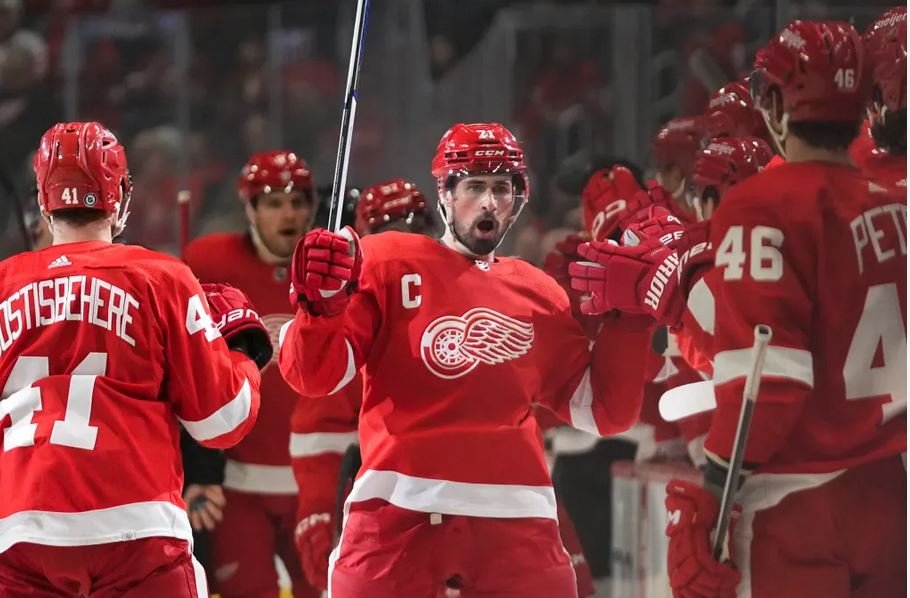NHL
Detroit Red Wings Acquired defenseman from the Calgary Flames in a three-team trade that also involved the Philadelphia Flyers…

The recent three-team trade involving the Detroit Red Wings, Calgary Flames, and Philadelphia Flyers has stirred considerable interest and analysis within the NHL community, marking a significant moment in the offseason roster adjustments for these teams. Trades of this nature are complex endeavors that involve careful consideration of player talent, team needs, and long-term strategic goals, all of which shape the competitive landscape of the league.
At the heart of this trade was the Detroit Red Wings’ acquisition of a defenseman from the Calgary Flames. Defensemen are pivotal players in hockey, responsible for protecting their own net, initiating offensive plays, and providing stability and leadership on the ice. The addition of a defenseman can profoundly impact a team’s defensive structure, playmaking abilities, and overall competitiveness in the NHL.
For the Detroit Red Wings, a storied franchise with a rich history of success in the NHL, this trade represents a strategic move aimed at bolstering their defensive capabilities. Under the leadership of general manager Steve Yzerman, the Red Wings have been undergoing a meticulous rebuilding process, prioritizing the development of young talent while selectively adding experienced players to complement their roster.
The decision-making process behind trades of this magnitude involves extensive evaluation and negotiation among the involved teams. Factors such as player contracts, salary cap implications, and future draft considerations all play crucial roles in shaping the terms and outcomes of the trade. In this case, the trade likely required the Red Wings to assess their defensive needs, identify suitable trade partners, and negotiate terms that would benefit all parties involved.
From the perspective of the Calgary Flames, who parted ways with the defenseman in question, the decision to engage in this trade reflects their own strategic objectives and roster management priorities. NHL teams regularly evaluate their rosters to optimize performance, address positional needs, and align player acquisitions with long-term franchise goals. The Flames’ involvement in this trade suggests a calculated approach to reshaping their defensive lineup or reallocating resources to address other team needs.
The inclusion of the Philadelphia Flyers as a third team in this trade adds a layer of complexity and collaboration to the transaction. In multi-team trades like this one, teams often leverage their assets and negotiate mutually beneficial deals that address multiple roster needs simultaneously. Such trades require careful coordination among general managers and front-office personnel to ensure that each team’s objectives are met while adhering to league regulations and financial constraints.
Beyond the logistical aspects, trades of this nature also generate significant interest and speculation among fans, analysts, and media outlets. The NHL community closely follows player movements and trade negotiations, analyzing their potential impact on team dynamics, playoff contention, and overall league competitiveness. For the Red Wings, Flames, and Flyers trade, reactions from stakeholders may vary based on individual assessments of player value, team strategy, and the broader implications for the upcoming season.
For the Detroit Red Wings specifically, the acquisition of a defenseman from the Calgary Flames signifies a strategic investment in their defensive depth and overall team structure. Defense is a critical component of successful hockey teams, providing the foundation for effective team play and minimizing opponent scoring opportunities. By adding a defenseman through this trade, the Red Wings aim to strengthen their defensive lineup, optimize player roles, and enhance their competitive position in the NHL’s highly competitive Central Division.
General manager Steve Yzerman’s reputation for astute decision-making and long-term planning likely influenced the Red Wings’ approach to this trade. Yzerman, a former NHL player and widely respected executive, has consistently demonstrated a commitment to building sustainable success through a combination of player development, strategic acquisitions, and prudent roster management. His leadership and vision for the Red Wings’ future have guided the team through a period of transition and positioned them for continued growth and improvement.
From a broader perspective, trades like the one involving the Red Wings, Flames, and Flyers underscore the dynamic nature of professional sports and the strategic calculus involved in team management. In a league as competitive and fast-paced as the NHL, teams must continually adapt their rosters to maintain competitiveness, respond to injuries or performance fluctuations, and position themselves for postseason success.
The impact of trades extends beyond the players involved, influencing team chemistry, fan engagement, and the overall trajectory of a franchise’s season. As such, the Red Wings, Flames, and Flyers trade will be closely monitored and analyzed within the hockey community for its strategic implications, impact on team dynamics, and potential long-term consequences.
The three-team trade involving the Detroit Red Wings, Calgary Flames, and Philadelphia Flyers represents a significant transaction in the NHL landscape. The acquisition of a defenseman by the Red Wings underscores their commitment to strengthening their defensive capabilities and positioning themselves for future success. As fans and analysts dissect the trade’s implications, it serves as a testament to the strategic complexity and dynamic nature of player acquisitions in professional hockey.
-

 NFL2 months ago
NFL2 months agoBREAKING: Steelers Best Quarterback Suspended for 6-Months Due to…
-

 NCAA1 month ago
NCAA1 month agoI am No Longer Comfortable at Illinois Fighting Illini, Quarterback Cal Swanson Cries Out…
-

 NFL2 months ago
NFL2 months agoJust In: Unexpected Name Surfaces in Rumors for Steelers Coaching Position.
-

 NFL2 months ago
NFL2 months agoRaheem Morris threaten to leave Atlanta Falcons if the Owners fails to….
-

 NFL2 months ago
NFL2 months agoGiants QB Daniel Jones to Undergo 12-Months Suspension After He was Found to be…
-

 NHL2 weeks ago
NHL2 weeks agoMinnesota Wild Veteran Player Announces Plan to Leave Team, Cites Poor Management…
-

 NBA2 months ago
NBA2 months agoBREAKING NEWS: LeBron James Has Agreed to Extend His Current Contract at Lakers worth $147.7 millions till…
-

 NHL2 months ago
NHL2 months agoHow should the Chicago Blackhawks handle their unsigned free agents for 2024–2025? Read to Find Out…..












